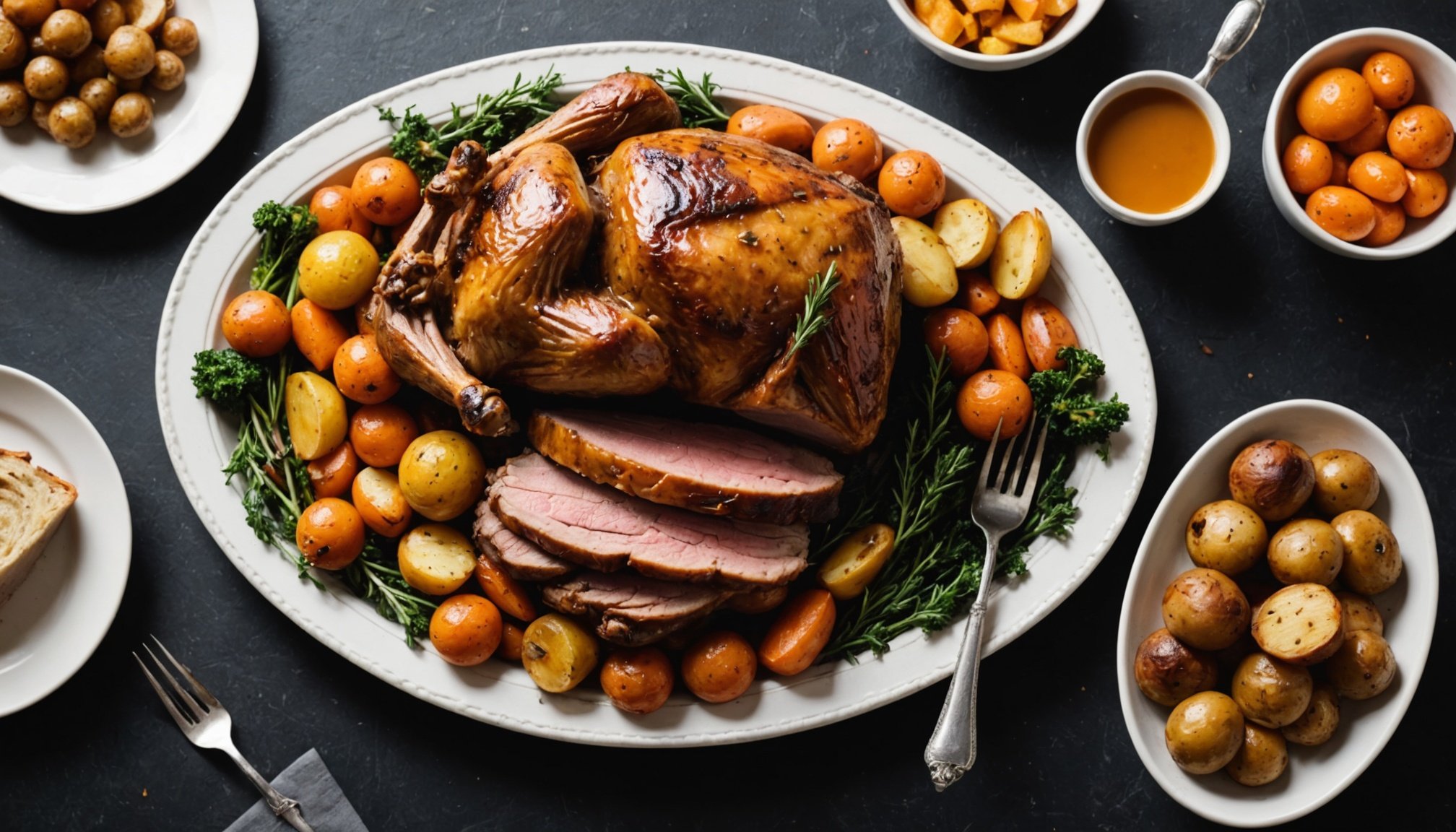Understanding the Essentials of a Sunday Roast
A traditional Sunday roast is a cherished meal that brings together the joys of hearty comfort food. Central to this meal is choosing the right meat, often beef, lamb, or chicken, which forms the cornerstone of the dish. Each type of meat delivers a unique flavour profile, and selecting the perfect cut is crucial for mouth-watering results. For instance, a rib of beef or leg of lamb is ideal for a conventional oven roast due to their ability to retain juiciness and develop a delectable crust.
The Sunday roast wouldn’t be complete without its essential components. Alongside the main protein, classic accompaniments typically include potatoes roasted to a golden crisp and a selection of seasonal vegetables such as carrots and parsnips, adding colour and nutrition to the plate. Keep staples like herbs, stock, and a splash of wine handy for the gravy, as they work wonders in elevating the flavours of the meal.
Also read : Essential ingredients for crafting an authentic lancashire hotpot recipe
In this culinary tradition, the balance of flavours and textures is key. Mastering the basics ensures a delightful experience for all at the table, making every Sunday roast an occasion to remember.
Preparing the Meat
Achieving the perfect Sunday roast calls for a precise approach to roasting techniques, starting with the right seasoning and marinating methods. Marinating allows the flavours to penetrate, enhancing the taste and tenderness of the meat. Ideally, marinate the meat the night before using ingredients like herbs, garlic, and olive oil.
Additional reading : Discover the top techniques for perfectly tender braised meats
When selecting meat for a conventional oven, choose cuts like beef rib, pork loin, or chicken quarters. These cuts are well-suited for roasting as they maintain moisture and develop a delightful crust. Proper seasoning, using a mix of salt, pepper, and your favourite herbs, helps create a delicious outer layer, sealing in the juices.
Techniques such as searing the outside on high heat before placing it in the oven will help achieve that perfect crust while maintaining a tender interior. Remember to rest the meat after roasting to allow the juices to redistribute, ensuring each slice is flavourful and succulent.
By mastering these roasting techniques, your Sunday roast can become a masterpiece of taste and texture, impressively showcasing the seasoning and effort involved.
Cooking Times and Temperatures
Cooking a Sunday roast to perfection hinges on understanding precise cooking times and roasting temperatures. Each type of meat has a standard cooking time, often calculated based on weight. For instance, beef generally requires 20 minutes per 450g at a roasting temperature of 200°C, while lamb and pork typically need 25 minutes per 450g at the same temperature. Accurate cooking times ensure meat doneness and yield the desired tenderness.
Internal temperatures are a reliable measure of doneness. Use a meat thermometer to check: beef should reach 60°C for medium-rare, lamb 70°C for medium, and pork 75°C for safe consumption. Recognising these temperatures allows for perfect satisfaction of preference.
Roasting temperatures can vary depending on the cooking method. Slow-roasting, at lower temperatures, enhances tenderness by breaking down connective tissues over a longer duration, while a high-temperature roast provides a quick, crispy exterior. However, both methods result in flavourful meals with correct adaptation.
Adjustments in cooking times and temperatures account for personal preference and achieve the perfect Sunday roast experience, balancing tenderness and flavour.
Accompaniments and Side Dishes
Crafting the perfect Sunday roast goes beyond just cooking the meat; the right traditional sides are essential. Potatoes, roasted to perfection, are a favourite, offering a crisp exterior with a fluffy inside. Preparing these alongside the roast means you can utilise the oven’s heat efficiently, making them both practical and delicious.
Seasonal vegetables, such as carrots and parsnips, complement the roast beautifully with their earthy flavours and vibrant colours. To maximise their taste, consider adding them to the roasting pan in the final stages of the meat’s cooking time. This allows them to absorb the rich drippings from the meat, making them more flavourful and tender.
A well-prepared gravy, crafted from the meat drippings, herbs, and a splash of wine or stock, elevates the dish to new heights. By deglazing the pan, you’re not only gathering the flavourful bits left from roasting but also enhancing the overall taste.
Remember, each side dish should add a unique texture and flavour, ensuring every bite of your Sunday meal is as enjoyable as the last.
Troubleshooting Common Issues
A delightful Sunday roast can face bumps, but understanding cooking problems like overcooked meat or uneven cooking equips you for success. If meat turns out overcooked, try a strategic remedy: prepare a gravy using the pan’s juices, adding some broth or wine to reintroduce moisture. This helps salvage flavour and juiciness.
Uniform cooking is crucial. To address uneven cooking, ensure you rotate the meat. Turning the roast halfway through cooking, especially when using a conventional oven, encourages even heat distribution.
A meat thermometer remains indispensable. It confirms the roast is done without slicing open prematurely, ensuring you achieve the ideal doneness. Mistakes happen, and having a flexible mindset is key. For example, if external charring threatens to overtake inner tenderness, foil wrapping can mitigate high heat, balancing crust formation with internal cooking.
Experiment with roasting temperatures. Switching to a lower setting can prolong cooking, promoting tenderness without drying out the surface. Remember, even seasoned chefs face challenges with a Sunday roast, but the right approach turns trials into tasty triumphs.
Variations for Dietary Needs
Creating a Sunday roast can accommodate various dietary needs without compromising flavour. For plant-based or vegetarian alternatives, a nut or lentil loaf can replace the traditional meat, offering a hearty and protein-rich substitute. These options retain the classic roast appeal while meeting vegetarian dietary preferences.
Gluten-free or low-carb diets require thoughtful adjustments. Opt for gluten-free flours when preparing gravies or use arrowroot or cornstarch as thickening agents. Swap out traditional potatoes for keto-friendly vegetables like cauliflower or turnips to make the meal low-carb while still delicious and satisfying.
To enhance the flavour of alternative roasts, consider adding rich seasonings such as smoked paprika or cumin. These spices impart depth to plant-based options, ensuring they are just as flavourful as their meat counterparts. Add herbs like rosemary and thyme to echo traditional roast aromas.
These dietary modifications, with a focus on alternative recipes, make the Sunday roast inclusive, catering to diverse dietary preferences while maintaining the essence and enjoyment of this cherished meal. Embrace creativity and experimentation to make the meal both adaptable and delightful.
Step-by-Step Recipe for a Perfect Sunday Roast
Creating a perfect Sunday roast involves a meticulous approach, balancing tradition with precision. This step-by-step guide ensures you achieve a delectable and satisfying meal.
Ingredients List
Start with these key components:
- Prime cut of meat: Beef rib, lamb leg, or chicken quarters
- Seasoning mix: Salt, pepper, fresh rosemary, and thyme
- Vegetables: Potatoes, carrots, parsnips
- Pantry staples: Olive oil, garlic, stock, and wine for gravy
Preparation Method
- Marinate the Meat: Apply olive oil and seasoning mix, incorporating herbs. Allow to sit overnight for flavour infusion.
- Prepare Vegetables: Chop potatoes and root vegetables into uniform pieces for even cooking.
Roasting Instructions
- Preheat your conventional oven to 200°C.
- Sear the meat: Heat a pan, sear each side for a perfect crust.
- Roast: Transfer meat and vegetables to a roasting pan. Roast for the recommended time based on meat weight.
- Prepare Gravy: Remove meat post-cooking, letting it rest. Simmer roasting pan drippings with stock and wine for a luxurious gravy.
This detailed guide simplifies the cooking process, ensuring a memorable feast with precision and flavour.
Tips for Presentation and Serving
Elevating your Sunday roast from delicious to dazzling involves paying attention to the presentation. Begin by focusing on serving techniques that enhance the visual appeal of your dish. Use a wide platter to arrange the roast and accompaniments, allowing each component to shine.
When it comes to meal plating, balance is key. Aim for a mix of colours and textures on the plate, such as vibrant vegetables alongside golden potatoes. Consider the portion sizes to ensure a satisfying yet elegant serving. A general guideline is approximately 125g of meat per person, accompanied by generous helpings of each side dish.
Garnishing can add a fresh touch. Use herbs like rosemary or thyme for an aromatic finish or a sprinkle of coarse sea salt for a subtle crunch. This enhances both taste and aesthetics.
Add the finishing touches by incorporating visual elements like a drizzle of rich gravy on the roast or a splash of sauce around the edge of the plate. These simple steps will leave a lasting impression, making your Sunday meal not just a feast for the stomach but also for the eyes.


